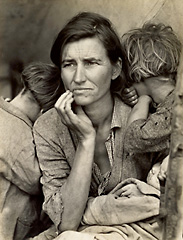I saw and approached the hungry and desperate mother, as if drawn by a magnet. I do not remember how I explained my presence or my camera to her, but I do remember she asked me no questions. I made five exposures, working closer and closer from the same direction. I did not ask her name or her history. She told me her age, that she was thirty-two. She said that they had been living on frozen vegetables from the surrounding fields, and birds that the children killed. She had just sold the tires from her car to buy food. There she sat in that lean-to tent with her children huddled around her, and seemed to know that my pictures might help her, and so she helped me. There was a sort of equality about it.
Dorothea Lange's photographs are some of the most influential work of all time. She began her career by opening a portrait studio but once the Great Depression began she decided to head outdoors to capture what people were going through. Shes known for her photography The Migrant Mother and is almost always used to depict the Great Depression in history books.

Dorothea Lange was a natural photographer. She could look at something as simple or as boring as a clothes line and make it seem beautiful and magical. I find her mesmerizing. I think that she is a real, honest to God Hero.
"The camera is an instrument that teaches people
how to see without a camera."
Today I heard Chris talking about this work, so I thought I would share one thought. As you mentioned, the image was taken to portray the Great Depression in America, in particular the bad conditions in which people where living. It is interesting where D.Lange said: ...and she seemed to know that my pictures may help her, and so she helped me' This makes me think about the connection between photographer and subject.
ReplyDeleteThose images did help raise awareness among citizens about the precarious conditions rural people where living in. However, I can't help to ask if one may think differently after knowing that the shots where carefully staged by the artist to emphasize the issue.
Does that piece of information make you think less of the success of the image? or does it not affect your credibility, and appreciation at all?
Tough question. I don't think it takes away too much. If anything, I think it's smart for an artist to use the resources in his/her environment (even to go as far as specifically arranging them )if it helps them communicate an idea.
ReplyDeleteGood comments. Don't you think it is interesting how we come to value a photograph? Its true, originally, this image was made with an agenda (well-meaning propaganda, one might argue) to raise awareness of the migrant farmer worker's plight during the depression --with the hope of raising support for relief efforts. It was largely "successful" in this regard. As "documentary" the image has been controversial due to the photographer's involvement in directing the subjects to portray a particular sentiment / desired effect. Then the image found a new "venue" so-to-speak in the pantheon of great photography, appreciated for its artistic merits, as an example of a "work" by a 20th century master photographer. It started as propaganda and ended up as "fine art" !
ReplyDeleteSo... how work gains currency and value is highly variable and can sometimes seem arbitrary.